Now that Jose Mourinho has been in charge of Tottenham Hotspur for just over three months, it’s once again time to look at the work he’s doing and if the team is going in the right direction with him at the helm.
Of course, the situation seems at least a bit better than it was in Mauricio Pochettino’s final days, as we will discuss further down the line of this tactical analysis, but things are far from perfect in Mourinho’s part of London and we’ll be looking through some of the issues he is currently facing.
A lot of that is simply due to his squad being extremely thin in some parts of the pitch but they still have more than just a solid base for the not so distant future. So without further ado, this tactical analysis will now shift towards Tottenham Hotspur’s attacking and defensive tactics, identifying some of the most prominent strategies the Lilywhites are using within Mourinho’s philosophy but also some of the areas that are still lacking.
Attacking style of play
Long ball routines
Mourinho has never really been known for his exemplary attacking tactics and even though we’ve seen some improvements in Spurs’ general success, including their offensive strategies, this is the part his team still struggles with the most.
As a general rule of thumb, the Special One is more precautious and pragmatic when attacking, which has become even more emphasised with the long-term injuries to both Harry Kane and Heung-Min Son, and will adjust his offensive tactics in such a way that they never leave him too open or too exposed.
In 2019/20 and especially under their new coach, Tottenham Hotspur have mostly set up in a 4-2-3-1 system, favouring it in 33% of all the games played throughout the campaign and across all competitions.
When attacking, Spurs rely heavily on their full-backs to provide width but interestingly enough, Mourinho uses a lopsided 4-2-3-1, meaning that one of the full-backs, usually the left-back, will stay behind in attack, while the other will burst forward and get into the final third. You can see how exactly that looks like in the image below.
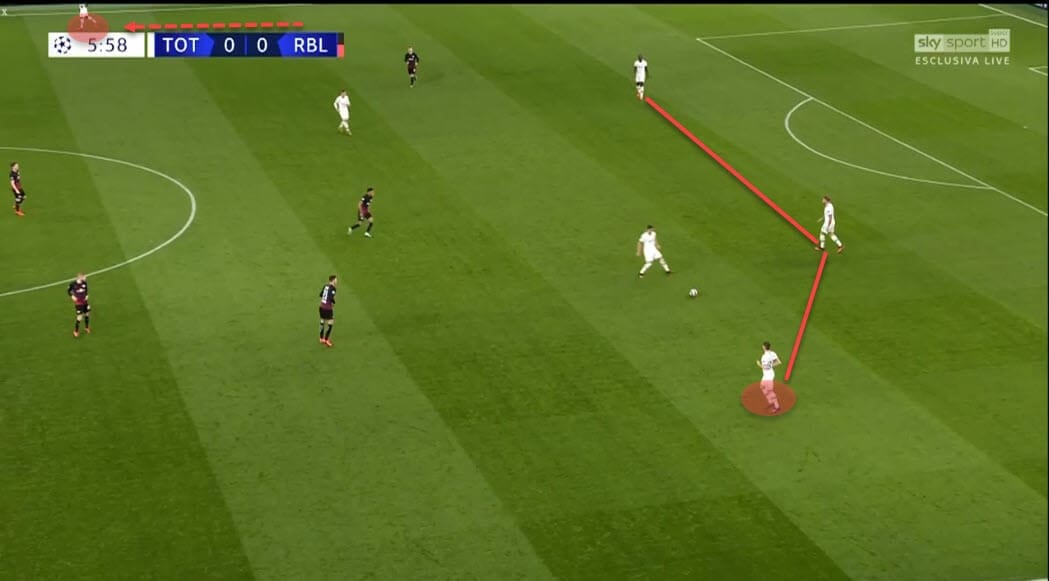
Even though it is a 4-2-3-1 on paper and that’s usually how Spurs would start their games but once they get into possession, this system changes to a 3-2-5 or a 3-2-4-1 formation, with the left-back – in this case, Ben Davies – staying behind to form a back three and the right-back – usually Serge Aurier – will step forward into the midfield or even as high as the wingers.
This all highly depends on the personnel Mourinho chooses. Ben Davies and Jan Vertonghen are more defensive-minded so that makes the left more pragmatic in the first place. Aurier, on the other hand, is a much more attacking-minded player and the coach is using his skill set quite well. However, if Japhet Tanganga is picked ahead of him, that immediately affects the whole flank as the youngster is not as aggressive as his teammate.
Still, it does seem like Mourinho is still experimenting with his squad but generally, he favours a more direct approach that completely bypasses the middle of the park and aims to advance through the flanks for the majority of the time. This could be due to a couple of reasons.
Firstly, his pivot duo choice affects this massively – at the moment, only Harry Winks seems like a certain pick for the coach while his partners will change from Eric Dier, Tanguy Ndombele and recently even Giovani Lo Celso. Of course, once again, injuries have played a part here as Ndombele has rarely been fit for long enough to feature consistently.
But depending on the choice of that second midfielder, Spurs possess or don’t possess a dose of press-resistance in their pivot line. Winks can carry the ball forward and spray it wide if necessary but Dier is not as comfortable in possession and can be forced into mistakes. This might have prompted Mourinho to look for other solutions and resort to directly switching the play to the wings.
Notice below how a somewhat usual scenario for Tottenham Hotspur’s build-up tactics might look like. The play is usually focused on one flank where Spurs can either establish a numerical superiority or just invite pressure while their right-back, Aurier, hugs the touchline on the opposite side and waits for a long ball over the top.
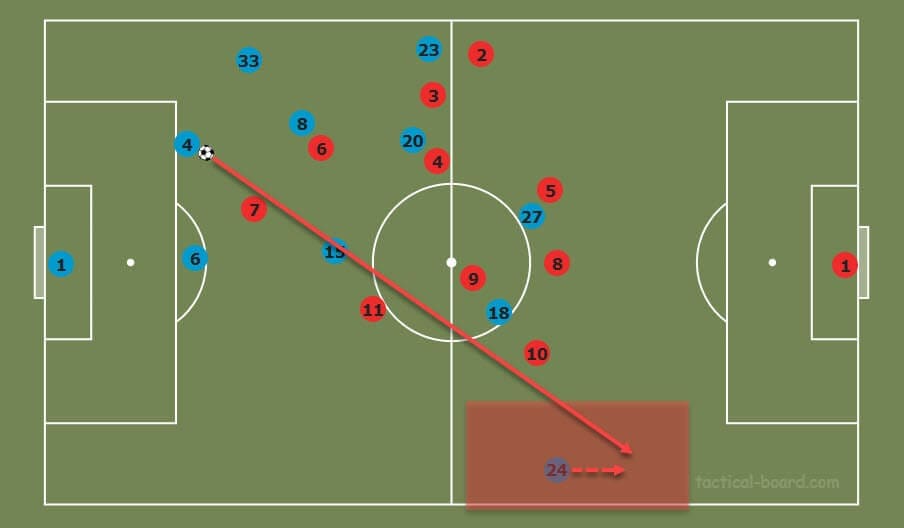
And this was especially true for Mourinho’s early days at the club when he would look to send long balls from his defensive line into the unoccupied space up front where his advanced full-back would lurk.
In the example above, we can see Tottenham Hotspur inviting pressure on the left just so they can switch the play onto the right side when the chance appears. The likes of Vertonghen are key with these particular tactics, however, as the centre-back is good enough on the ball to make the switch successfully.
But the role of the double pivot is also particularly important and Mourinho seems to like them extremely close to the backline, as a way of solidifying the defence but also in order to create space in the middle of the park for, once again, a potential long ball all the way from the back.
Let’s observe another way of attacking from the back that Tottenham Hotspur use under Mourinho in the following graphic. Sometimes, when they are pressurised, Spurs will drop deeper with their five-man defensive squad but the forwards, often Lucas Moura and whoever ends up being picked next to him – could be the likes of Lo Celso or Erik Lamela – push the opposition’s defensive line further forward, creating a gap in the middle that can be exploited.
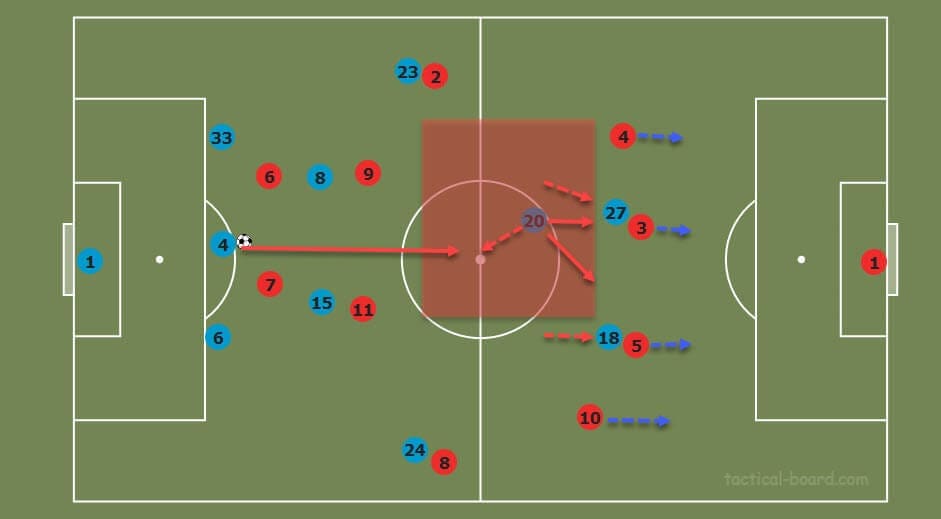
Once that gap appears, Dele Alli can drop and collect the ball and then progress it forward in a swift transition. Of course, this is easier said than done and one of the problems Spurs are currently facing is successfully avoiding the press and advancing the ball when pinned down in their own half.
We’ve seen that in their clash against Chelsea when Frank Lampard’s troops squeezed the life out of them and practically limited them to moving strictly inside their own backyard. But even in such a difficult situation, gaps appeared for them to exploit.
Notice in the image below how Spurs are one pass away from completely leaving Chelsea in the dust but a last-ditch tackle from the Blues saves the day. This is partly on Lampard’s tactics as well as his midfield was sometimes not optimally organised and gaps like that one appeared due to their own mistakes. But it’s also because Spurs managed to create them in the first place.
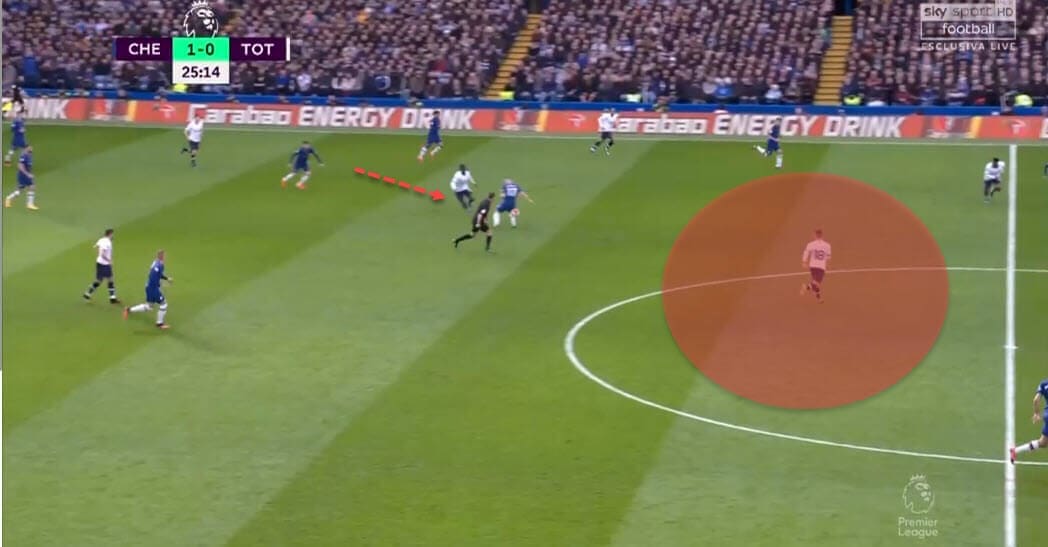
Generally speaking however, this transition towards a more direct approach can be seen in the stats as well. Spurs have averaged 43.58 long balls in Pochettino’s first 12 games in charge in 2019/20 while they now sit on 50.25 under Mourinho.
Similarly, they are now deploying fewer passes per possession: 4.95 under Pochettino and 4.36 under Mourinho in four games more so far in the ongoing campaign. Another indication might be their 481 passes on average in 2019/20 as opposed to their 516 throughout 2018/19.
Overloads and space creation
Even though we can often see Tottenham Hotspur under Mourinho prefer that direct route towards the opposition’s goal, they do have a couple of tactics in their arsenal that make for some interesting positional play.
In Kane, of course, Spurs have a rather unique striker who is heavily involved in the build-up and can often be seen dropping deep to smoothen the link-up play and successfully create overloads. In his absence, however, Mourinho has mostly chosen Moura to do that role.
Similarly to the English striker, Moura will also regularly vacate his position and drop off to help progress the ball. Notice below how his movement into the midfield poses a real conundrum for the opposition as they suddenly don’t know who to mark in this situation.
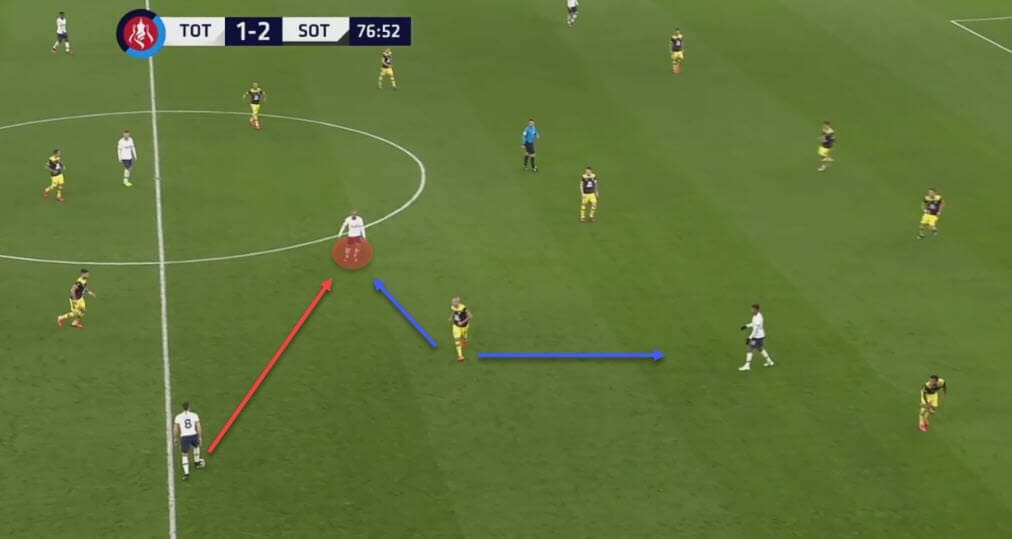
And due to that, Spurs can advance the ball to a higher platform through the Brazilian who then has the ability to carry it upfield and into the final third, ultimately generating a big chance for his team.
Once again, Spurs will utilise his movement to create space behind the opposition’s backs and will then send a through ball into the final third and into the path of a sprinting teammate. Notice in the example below as they create the very same thing from a throw-in routine.
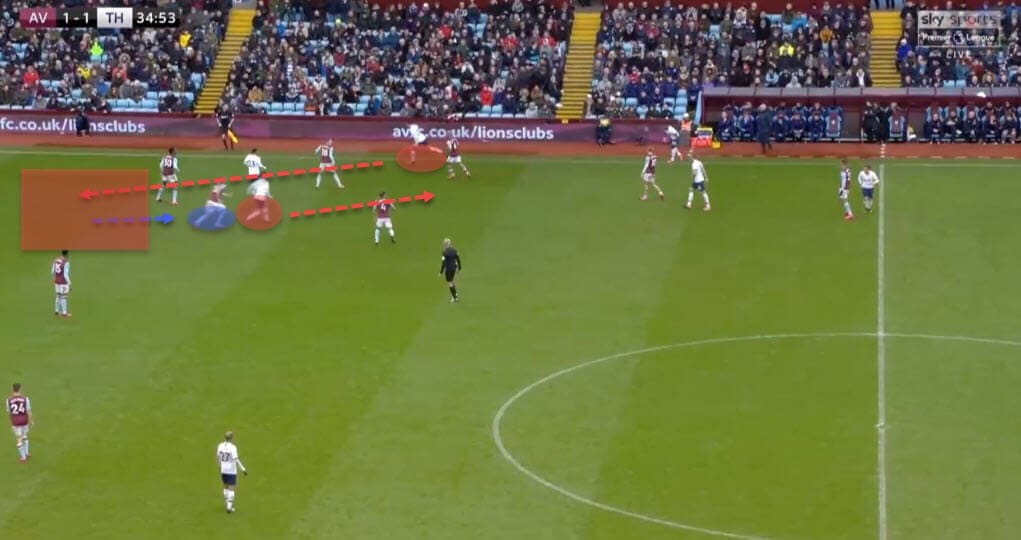
The forward drops deeper, pulling his marker with him and that creates space behind them. Upon receiving the ball from the throw-in, he immediately sends it over the top and into the path of the player who’s already on his way into the gap that suddenly appeared in their opposition’s backline.
This is a strategy commonly used by Spurs under Mourinho and it usually involves Moura himself. Take a look at another perfect example down below where exactly the same thing happens once again.
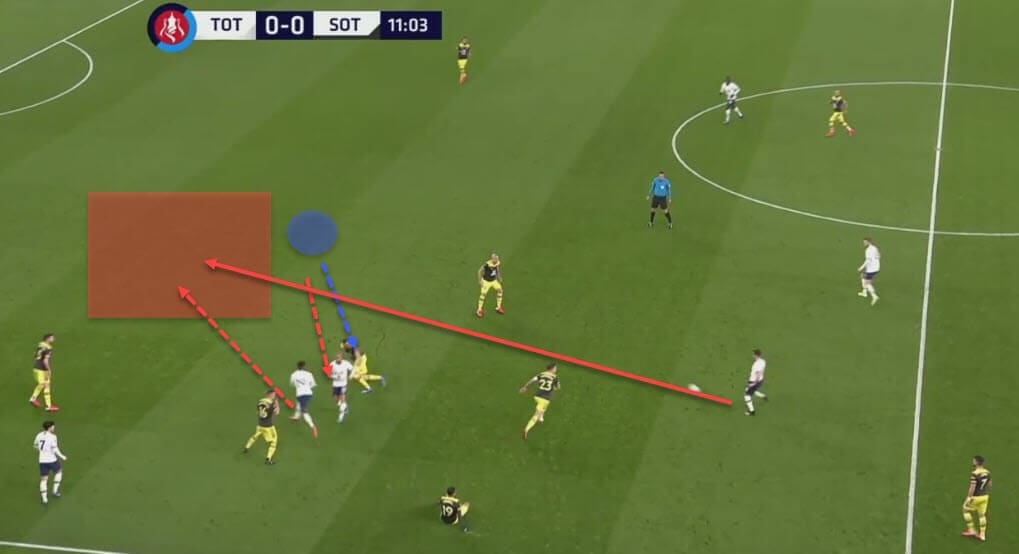
The defender is dragged away from his standard position and Spurs can immediately send a long ball over the top to find a runner who’s now in acres of space behind the enemy lines. It’s a simple technique that’s utilised by many teams but it works like a charm when executed properly.
And just as they use the long balls from their defensive line to find teammates in space on the other side of the pitch, they tend to use the pace of their forwards almost as much. The likes of Bergwijn and Son, when he’s fit, have that burst of speed that can be utilised for off the shoulder runs in behind the defence.
One of the problems, however, that have somehow crept in as of late seem to be connected to Tottenham Hotspur’s lack of width in general but especially on the left side of the pitch. We’ve mentioned at the very beginning of this tactical analysis that Mourinho is often using a lopsided system that sees one side be more attacking than the other.
But if his forwards who either start the attack out wide or who sometimes drift out there decide to cut inside, this leaves Spurs without any personnel on that flank and their actions suddenly become too central and can easily be defended against.
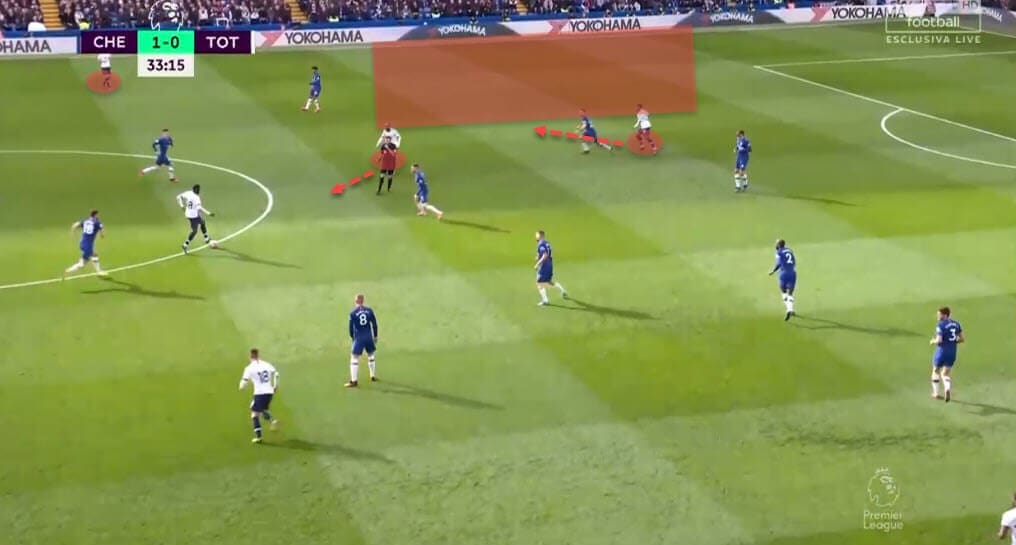
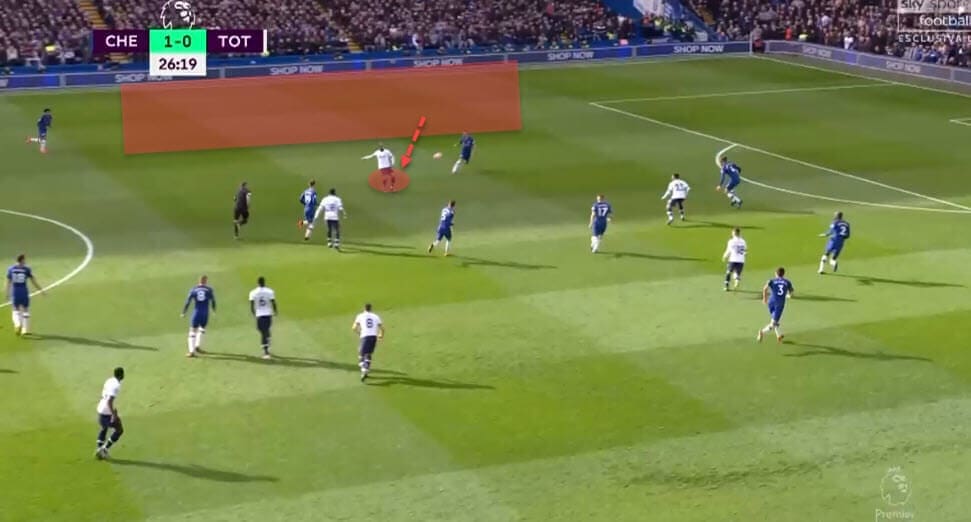
Note in both examples above how once Moura cuts inside from the left, Chelsea can basically disregard the whole flank since Davies doesn’t move past the halfway line. While a lopsided formation makes defensive transitions easier to execute since there won’t be two full-backs caught too high up the pitch in case of a turnover, it does mean that the emphasis of their attack can often be too focused on just one of the flanks.
Defensive style of play
Let’s move to the defensive style of play of Tottenham Hotspur under Mourinho. Generally speaking, both the defensive and offensive tactics have been improved under the Portuguese manager despite hiccups in both phases of play.
But one big change that we have seen in Spurs ever since Mourinho has taken over the team is the reduction in pressing tactics. The Special One prefers a solid and compact defensive unit over a high-pressing one that tries to win the ball higher up the pitch.
As a result, upon losing possession and during the opposition’s build-up play, Spurs will mostly drop into their usual 4-4-2 defensive shape that can turn into a 4-3-3 once the ball is recycled towards the wings and low pressure is applied on the ball-carrier. You can see an example of that in the image below.
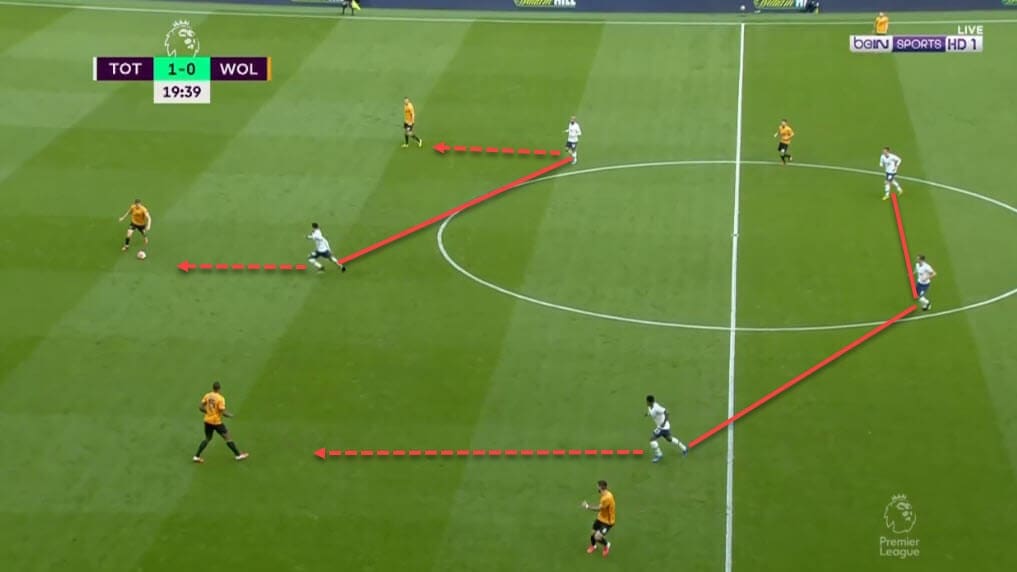
This is a stark difference from the system Pochettino preferred as his team was always adamant in trying to recoup possession higher up the pitch and pressed rather intensely. At the moment, this is pretty evident in their PPDA values (passes allowed per defensive action) which stands at 12.49 and is higher than in any of Pochettino’s previous years in charge.
But Pochettino has also been conceding more goals than Mourinho as his pressing mechanisms were far from perfect and the opposition would consistently find gaps in their approach. This resulted in 1.41 conceded goals in his last 12 Premier League games in charge while Mourinho is now on 1.37 in his 16 games in the league.
As opposed to expanding in their search of the ball, Spurs will now often turtle up in their own half and move as a compact unit, hunting for loose balls in their own backyard and deploying collapsing tactics once the opposition enter certain zones on the pitch.
Usual triggers for collapses are either miscontrol of the ball or the opposition positioning themselves in the wider areas where it’s easier to press them. In those instances, we can see them try to recover the ball at a high pace.
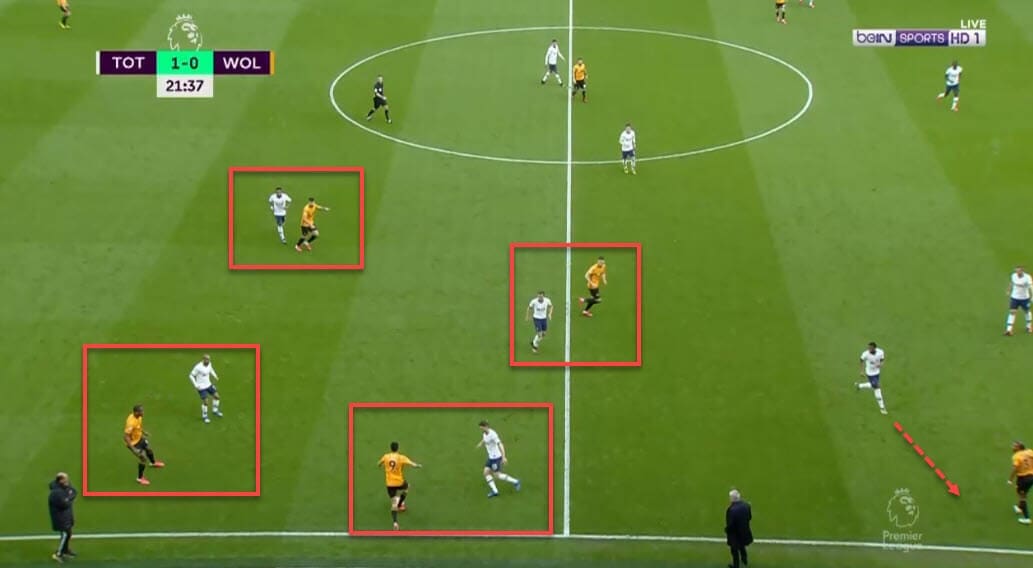
You can see an example of a combination of zonal and man-marking in the advanced areas of the pitch in the image above. Spurs have forced their opposition into an awkward position on the pitch and then aim to cut off all of their passing lanes to recover possession in their half of the park.
Additionally, the sheer compactness and the fact that some of their pacy players such as Alli, Moura or Bergwijn can stay higher up the pitch means that it’s far easier to construct a successful counter-attack and Spurs have made that a formidable weapon under Mourinho.
In that instance, upon retrieving the ball, the goal is to expand as quickly as possible, moving in various different directions so as to dismantle the opposition’s compact defensive shape and open gaps through which a ball can be played through.
Observe an example of that below as Spurs snatch the ball away around the halfway of the pitch and immediately the wide players burst forward and the central ones – who all stay relatively close to each other – combine quickly to eject the pacy players as soon as possible.
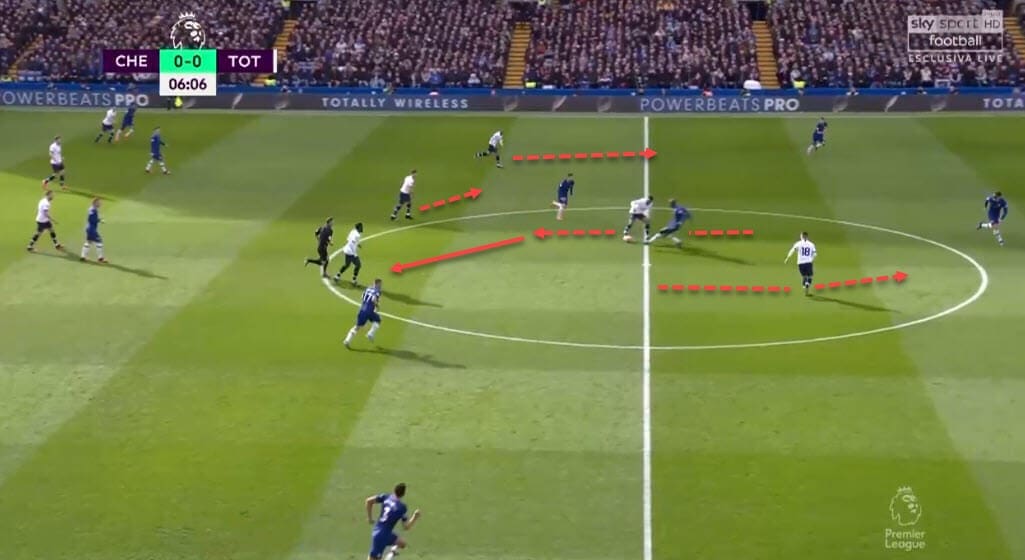
But generally speaking, and even though it may seem like they are still conceding a lot, stats do suggest an improvement is taking place. Pochettino registered 1.66 xGA (expected goals against) in his last 12 games while Mourinho is currently on 1.49 xGA after 16 games.
Still, their defensive organisation is not without fault and we’ve seen some of their biggest weaknesses exposed against Chelsea and RB Leipzig respectively. Spurs were on the backfoot in both games and similar mistakes crept in that gave their opposition multiple openings.
In both cases, their goal was to overcrowd the middle of the pitch, which also seems like something Mourinho likes to do in order to stop the progression of the ball. Against Leipzig, however, they failed to cover their half-spaces successfully and it led to their opposition constantly exploiting that area.
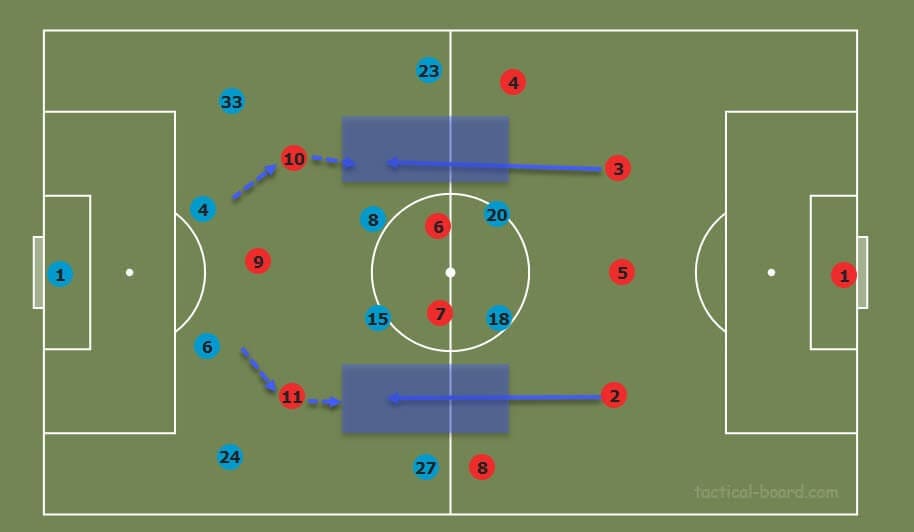
You can see how that looked like on the pitch in the graphic above. While Spurs manage to cage the opposition’s midfield, their narrow and compact positioning means that the half-spaces are left wide open and Leipzig constantly progressed the ball through those channels.
Against Chelsea, however, we saw two different issues primarily come to light. Mourinho once again decided to sit deep and overcrowd the middle of the park in hopes of squeezing the ball away from the Blues and striking on the counter. But at times, they would commit men forward and actually be proactive in their approach.
Unfortunately, it seems that their pressing tactics are still somewhat lacking, as was the case with Pochettino at the helm and that might actually be a reason why Mourinho is opting against them in the first place.
Spurs were not compact enough when pressing Chelsea and huge gaps between their lines appeared in the process, leaving the Blues with multiple dangerous options to exploit while playing from the back. You can see an example of a disjointed press by Spurs in the following example.
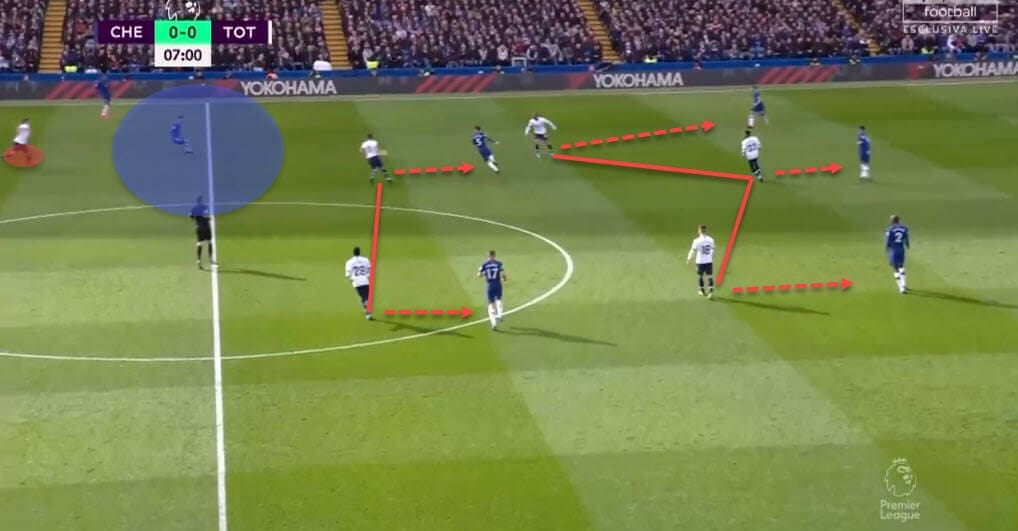
Their first two lines of the pressing squad charge forward but the backline doesn’t follow suit and is late to react, leaving Chelsea’s player in a really dangerous position in the opposition’s half, totally unmarked.
Additionally, and this is through no fault of Mourinho’s, without Kane in the front, Spurs are still lacking a focal point in attack and a proper target man who can increase their chances of winning the first ball and then successfully laying it off to his teammates. When you’re defending deep and are depending on having a clear target for those long balls, the absence of such a player can hurt the team massively.
So far, Moura has been doing that job decently but with the eventual return of the Englishman, their improvement should be more than just evident.
Final remarks
It does seem like Mourinho is steadily improving Spurs even though results are far from ideal. The team is sitting in eighth with 40 points under their belts at the moment of writing this tactical analysis but their expected points tally says they should only have 36.6 and be sitting in 11th.
Similarly, they are overperforming their xG values as well with 41.11 and 46 goals scored in the process. It’s the same story with their defence since they have conceded 39 goals while they should’ve allowed 43.96 according to the xG map.
Overall, however, and especially since his team is largely plagued by injuries, it seems that Mourinho is coping decently well with the resources he has. They are still creating more chances and conceding less than they have under Pochettino and that’s a great sign for the squad.
But there are still issues that have to be ironed out if this team is to tango with the best of them. Their lacklustre pressing tactics, no proper target man for transitions, lack of any width in the pragmatic approach and gaps they leave in their defensive shapes have already cost them quite a lot in the ongoing campaign and will definitely have to be taken care of in the not so distant future.
At times it feels like Mourinho is failing at who he’s supposed to be and that’s the rigid master of defensive tactics who’s able to create the most stable and compact units that have graced the pitch. But so far, we’re yet to see that kind of resolute performances from his Tottenham Hotspur team and a lot more will be expected from the Special One in the future.

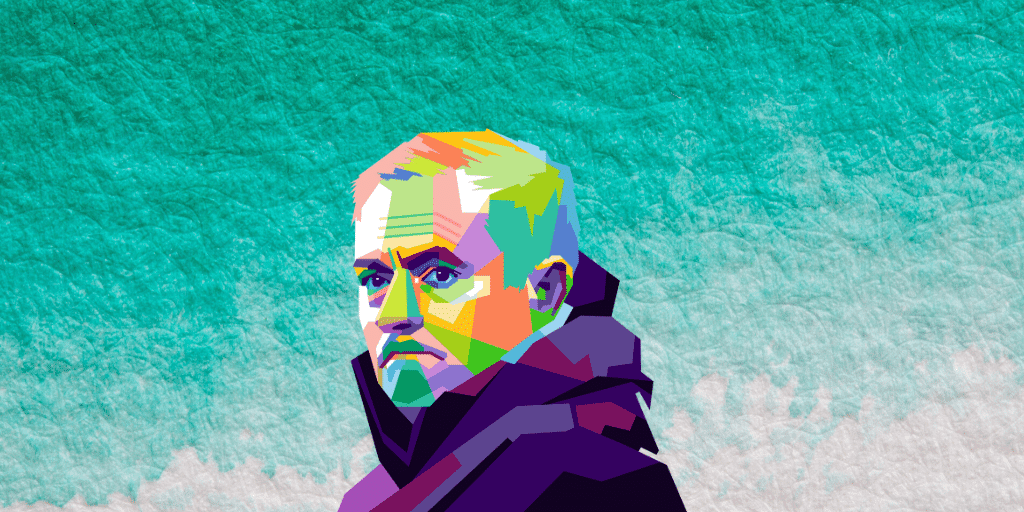




Comments